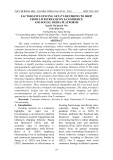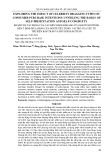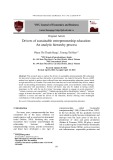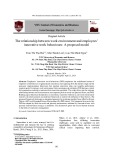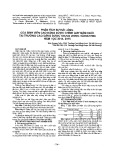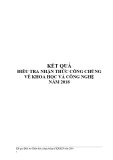
Số 328 tháng 10/2024 53
ĐO LƯỜNG TRÌNH ĐỘ DÂN TRÍ TÀI CHÍNH
CỦA SINH VIÊN VIỆT NAM
Phan Hữu Nghị
Trường Đại học Kinh tế Quốc dân
Email: nghiph@neu.edu.vn
Bùi Nhật Quang
Trường Đại học Kinh tế Quốc dân
Email: buinhatquang03@gmail.com
Đào Hải Nam
Trường Đại học Kinh tế Quốc dân
Email: namhaidao321@gmail.com
Mã bài: JED-1810
Ngày nhận bài: 14/07/2024
Ngày nhận bài sửa: 17/09/2024
Ngày duyệt đăng: 05/10/2024
DOI: 10.33301/JED.VI.1810
Tóm tắt
Vai trò của dân trí tài chính trong bối cảnh hội nhập và phát triển kinh tế đang ngày một được
đánh giá cao ở cả các nền kinh tế phát triển và đang phát triển, chiếu theo yêu cầu của sự phổ
biến mà đầy phức tạp của các sản phẩm tài chính hiện nay. Trên cơ sở lý thuyết từ các nghiên
cứu trước, nghiên cứu này đề xuất một khái niệm thống nhất cho dân trí tài chính - một khái
niệm đa chiều với ba nội hàm là thái độ tài chính, hành vi tài chính và kiến thức tài chính.
Nghiên cứu sử dụng phương pháp bảng hỏi để thu thập dữ liệu sơ cấp, có cỡ mẫu là 584 sinh
viên đang học tập tại các trường đại học của Việt Nam và phân tích bằng phương phápmô hình
cấu trúc tuyến tính. Kết quả thu được cho thấy cả ba nội hàm này đều có mối liên hệvới dân
trí tài chính, trong đó hành vi tài chính thể hiện sự tương quan lớn nhất, theo sau bởi thái độ
tài chính và cuối cùng là kiến thức tài chính.
Từ khoá: Dân trí tài chính, hành vi tài chính, kiến thức tài chính, thái độ tài chính.
Mã JEL: G41, G53, I31.
Defining and measuring financial literacy of Vietnamese young adults
Abstract
The role of financial literacy in the context of integration, globalization and economic
development has garnered growing appreciation in both developed and developing economies
to meet the requirements of the prevalence yet sophistication of current financial products.
This study, thus, proposed a composite definition for financial literacy as a multidimensional
concept with three components - namely financial attitude, financial behavior, and financial
knowledge - before developing a measurement scale based on theoretical synthesis from
previous studies. The study used the questionnaire method to collect primary data, with a
sample size of 584 students from Vietnamese universities and colleges. The reflectiveness of
financial literacy through the said components is confirmed through the use of Structural
Equation Modeling analysis via AMOS. The results show that all three assumed components
exhibit statistically significant correlations with financial literacy, whereas financial behavior
displays the highest correlation, followed by financial attitude and, lastly, financial knowledge.
Keywords: Financial attitude, financial behavior, financial knowledge, financial literacy.
JEL Codes: G41, G53, I31.

Số 328 tháng 10/2024 54
1. Giới thiệu
Với sự phát triển của hệ thống tài chính toàn cầu, các sản phẩm tài chính ngày càng phổ biến, đa dạng và
phức tạp. Điều này đòi hỏi người sử dụng cần phải có một lượng kiến thức nhất định để có thể sử dụng hiệu
quả và tránh các vấn đề tiêu cực phát sinh khi dùng các sản phẩm tài chính này. Nói cách khác, việc hiểu khái
niệm tài chính và nhận biết các công cụ tài chính đóng vai trò rất cần thiết cho các cá nhân trong việc đưa ra
các quyết định tài chính. Theo OECD (2022), đánh giá mức độ hiểu biết về tài chính của người dân là một
thành phần quan trọng trong một chiến lược quốc gia thành công về giáo dục tài chính. Nghiên cứu đã chỉ
ra rằng, sở hữu một trình độ dân trí tài chính thấp kéo theo các vấn đề như gặp khó khăn trong việc quản lý
các khoản nợ và đầu tư (Lusardi & Tufano, 2009), giảm khả năng tham gia vào thị trường chứng khoán (Van
Rooij & cộng sự, 2011), không lập kế hoạch hưu trí (Lusardi & Mitchell, 2011) và khó tích luỹ cũng như
quản lý tài sản của mình (Hilgert & cộng sự, 2003). Ngoài ra, dân trí tài chính còn là yếu tố thiết yếu trong
việc quản lý dòng tiền và giúp quyết định hành vi tín dụng, thế chấp và thanh toán hoá đơn (Potrich & cộng
sự, 2016). Từ đó có thể khẳng định dân trí tài chính có vai trò to lớn không chỉ đối với các cá nhân mà còn
tổng thể nền kinh tế và việc nghiên cứu về dân trí tài chính là cần thiết cho bất kỳ quốc gia nào trên thế giới,
thể hiện qua việc các Nguyên tắc Cấp cao về Chiến lược Quốc gia về Dân trí Tài chính của Tổ chức Hợp tác
và Phát triển Kinh tế (OECD) được thông qua tại hội nghị G20 (OECD, 2017). Đặc biệt, cần tập trung vào
đối tượng là người trẻ do những thách thức về mặt tài chính với thanh niên nằm ở một mức độ nghiêm trọng
hơn bởi sự thiếu hụt về cả mặt vật chất lẫn tinh thần để tự khắc phục hậu quả nảy sinh từ những quyết định
tài chính sai lầm (Lusardi & cộng sự, 2010). Cũng theo Lusardi & cộng sự (2010), nghiên cứu về dân trí tài
chính ở người trẻ có tầm quan trọng đặc biệt đối với các nhà hoạch định chính sách. Đánh giá kịp thời về
dân trí tài chính của thanh niên có thể hỗ trợ việc thiết kế các chương trình giáo dục tài chính hiệu quả nhắm
vào thanh niên cũng như các nhà làm luật để bảo vệ những người tiêu dùng trẻ tuổi.
Lĩnh vực nghiên cứu về dân trí tài chính của giới trẻ Việt Nam sở hữu số lượng chưa nhiều và cũng chưa
thực sự sâu sắc. Hơn hết, hiện nay vẫn chưa có sự thống nhất về khái niệm và các nội hàm của dân trí tài
chính. Một số nghiên cứu coi dân trí tài chính gồm duy nhất một nội hàm trong khi có các nghiên cứu khác
coi dân trí tài chính gồm ba hoặc bốn hoặc năm nội hàm. Điều này gây khó khăn cho việc xây dựng một
thang đo chính xác để đo lường dân trí tài chính và dẫn đến một khoảng trống lớn trong lĩnh vực nghiên
cứu này. Nhận thấy khoảng trống này, nhóm nghiên cứu thực hiện nghiên cứu này nhằm đưa ra một khái
niệm thống nhất cho dân trí tài chính và xây dựng một thang đo dựa trên tổng hợp lý thuyết từ các nghiên
cứu trong và ngoài nước trước đây. Dữ liệu sơ cấp về các yếu tố đo lường trình độ dân trí tài chính của giới
trẻ Việt Nam được thu thập trong vòng 3 tháng (từ tháng 9 năm 2023 đến tháng 12 năm 2023). Đối tượng
là sinh viên đang theo học tại các trường đại học không giới hạn trên toàn bộ lãnh thổ địa lý của nước Việt
Nam, được tiếp cận thông qua bảng hỏi tự giám sát được phân phát trực tuyến với số lượng câu trả lời hiệu
quả là 584.
Kết cấu của nghiên cứu được chia làm năm phần. Sau phần giới thiệu về tính cấp thiết của nghiên cứu là
tổng quan nghiên cứu về dân trí tài chính cùng các yếu tố nội hàm; tiếp theo là khái quát phương pháp nghiên
cứu và tổng hợp kết quả cũng như đối chiếu, phản biện với các nghiên cứu đi trước; cuối cùng nhóm nghiên
cứu rút ra kết luận và một vài hàm ý chính sách.
2. Cơ sở lý thuyết và giả thuyết nghiên cứu
2.1. Dân trí tài chính
Cụm từ “Dân trí tài chính” được chuyển ngữ từ thuật ngữ gốc “Financial literacy”, trong đó “literacy”
dùng để chỉ khả năng biết đọc và viết của con người (Zarcadoolas & cộng sự, 2006). Về nghĩa rộng, khả
năng này bao gồm cả sự hiểu biết (kiến thức về từ ngữ, ký hiệu và toán học cơ bản) lẫn sử dụng (đọc, hiểu,
tính toán) các kiến thức này để phục vụ cho cuộc sống của mỗi cá nhân. Cách chuyển ngữ “Dân trí tài chính”
đã được các chuyên gia trong nước về lĩnh vực tài chính cá nhân công nhận bởi thuật ngữ “dân trí” đã bao
hàm khái niệm người dân và khái niệm trí tuệ cũng như khả năng sử dụng trí tuệ (Khúc Thế Anh, 2020).
Tại thời điểm nghiên cứu, vẫn chưa có một sự thống nhất về khái niệm chính xác cũng như nội hàm của
dân trí tài chính. Theo Huston (2010), phần lớn các bài nghiên cứu cho tới thời điểm đó không khẳng định
một khái niệm cụ thể cho dân trí tài chính. Kể từ những năm 1990, giới học thuật đã tiếp cận dân trí tài chính
dưới dạng một khái niệm đơn chiều hoặc là sự kết hợp giữa các yếu tố kinh tế-xã hội, cụ thể là nhận thức tài

Số 328 tháng 10/2024 55
chính, hành vi tài chính, kiến thức tài chính, thái độ tài chính, v.v. Nghiên cứu đầu tiên về dân trí tài chính
được công bố bởi Noctor & cộng sự vào năm 1992, trong đó khái niệm này được định nghĩa là khả năng đưa
ra những phán quyết và quyết định hiệu quả liên quan đến sử dụng và quản lý tiền. Thay vì tập trung vào khía
cạnh ứng dụng, Bowen (2002) đã đề xuất dân trí tài chính nên được coi là khả năng hiểu được những thuật
ngữ và khái niệm tài chính cần thiết cho cuộc sống thường ngày. Tương tự, Bumcrot & cộng sự (2013) coi
dân trí tài chính đơn giản là nắm bắt được các khái niệm tài chính cơ bản; trong khi Kadoya & Khan (2020)
đi sâu vào những khái niệm đó cụ thể là lãi suất, lạm phát, rủi ro và đa dạng hóa. Như vậy, các nhà nghiên
cứu này tập trung vào mặt “kiến thức” và “hiểu biết” của dân trí tài chính, mặc dù cách hiểu như vậy có thể
phát sinh vấn đề trong quá trình thiết kế nghiên cứu vì bản chất dân trí tài chính và kiến thức tài chính là
khác nhau (Potrich & cộng sự, 2016).
Cách khái niệm này của dân trí tài chính không đề cập đến khía cạnh mục tiêu lâu dài của dân trí tài chính
mà chỉ tập trung vào kiến thức hoặc hành vi (quyết định hiệu quả) trong ngắn hạn của đối tượng. Tuy nhiên,
khái niệm dân trí tài chính nên được tiếp cận dưới một góc nhìn đa chiều (Huston, 2010; Nguyen & cộng sự,
2017). Các khái niệm dân trí tài chính đa chiều không chỉ có sự mở rộng hơn so với một chiều ở việc đã bao
gồm nhiều nội hàm khác nhau của dân trí tài chính như kiến thức, thái độ, kỹ năng, độ tự tin, v.v. mà còn đề
cập đến mục tiêu mà việc nâng cao dân trí tài chính hướng đến. Cụ thể, mục tiêu đó là việc ra được quyết
định tài chính hiệu quả (Hastings & cộng sự, 2013). Mục tiêu này có thể đạt được thông qua việc kết hợp
kiến thức và hiểu biết của bản thân về các khái niệm tài chính cơ bản để hình thành những hành vi tài chính
tích cực hoặc kết hợp với kỹ năng tài chính thể hiện qua khả năng tính toán (Hastings & cộng sự, 2013).
Việc bao hàm ba nội hàm này của dân trí tài chính cũng được rất nhiều nghiên cứu ủng hộ (Potrich & cộng
sự, 2016; OECD, 2022). Ngoài ra, các nghiên cứu nhóm này cũng đề cập đến một khái niệm kết quả chung
là “thỏa mãn tài chính” (financial well-being) - sự hài lòng với mức sống hiện tại của bản thân và tự do về
tài chính - không phụ thuộc vào một cá nhân khác (Brüggen & cộng sự, 2017). Mở rộng hơn, Miller & cộng
sự (2009) cũng đề cập đến mục tiêu thỏa mãn tài chính nhưng đã bao quát thêm cả độ tự tin cũng là một cấu
thành của dân trí tài chính. Cụ thể, dân trí tài chính theo đó là sự kết hợp hiểu biết về sản phẩm tài chính với
độ tự tin của người tiêu dùng khi chấp nhận rủi ro và tận dụng cơ hội để đưa ra quyết định hiệu quả để cải
thiện mức độ thỏa mãn về tài chính. Ngoài ra, dân trí tài chính còn được coi là một phần của vốn con người
theo khía cạnh tài chính (Huston, 2010). Việc nâng cao dân trí tài chính thông qua các chương trình giáo dục
được kỳ vọng sẽ giúp phát triển nguồn nhân lực, góp phần nâng cao chất lượng và năng suất của lực lượng
lao động nói riêng và nền kinh tế nói chung.
Từ các cách định nghĩa trên, nhóm nghiên cứu đề xuất một khái niệm tổng hợp cho “dân trí tài chính”:
Dân trí tài chính là một tổ hợp kiến thức tài chính, thái độ tài chính và hành vi tài chính giúp con người đưa
ra được những quyết định hợp lý để hướng tới mục tiêu thỏa mãn về tài chính. Thông qua đánh giá kiến thức
về các khái niệm tài chính, thái độ với đồng tiền và hành vi tài chính tích cực, có thể xây dựng một thang đo
đánh giá mức độ dân trí tài chính một cách hiệu quả. Bên cạnh đó, tồn tại một vấn đề khác trong nghiên cứu
về kiến thức tài chính là sự nhầm lẫn giữa “kiến thức tài chính” (financial knowledge), “giáo dục tài chính”
(financial education) và “năng lực tài chính” (financial capability). Về vấn đề này, nhóm nghiên cứu đưa ra
sự phân biệt như sau: “kiến thức tài chính” là kiến thức tài chính của con người về các khái niệm tài chính
cụ thể (Huston, 2010); “giáo dục tài chính” đề cập đến quá trình một cá nhân nâng cao hiểu biết của họ về
các sản phẩm tài chính và những rủi ro liên quan nhờ thông tin, hướng dẫn và đánh giá khách quan thu được
(OECD, 2005); “năng lực tài chính” là một khái niệm bao gồm cả kiến thức tài chính và kỹ năng tài chính
giúp các cá nhân hiểu được tình hình tài chính của họ, kèm theo động lực hành động dựa trên kiến thức tài
chính đó. (HM Treasury, 2017). Đặt các khái niệm này vào thực tế, mỗi cá nhân sẽ có được kiến thức tài
chính thông qua giáo dục tài chính, từ đó dần dần phát triển năng lực tài chính để tự đưa ra quyết định - và
hiểu biết tài chính là ngưỡng năng lực trước khi kết hợp với trách nhiệm, sự tự tin, v.v. để hình thành năng
lực tài chính.
2.2. Giả thuyết nghiên cứu
Nghiên cứu này sử dụng bộ thang đo với nền tảng từ OECD (2022) do tính phù hợp nhất với khái niệm
đề xuất của chúng tôi. Thang đo này được phát triển bởi các chuyên gia về tài chính cá nhân hàng đầu để đo
lường trình độ dân trí tài chính và tài chính toàn diện mà trong đó các câu hỏi được đề xuất tập trung vào ba

Số 328 tháng 10/2024 56
nội hàm chính của dân trí tài chính như sau:
Thái độ tài chính đề cập đến cảm xúc và quan điểm của mỗi cá nhân đối với các vấn đề tài chính, có ảnh
hưởng trực tiếp đến hành vi và việc ra quyết định sau đó của họ (Rаi & cộng sự, 2019). Theo Khúc Thế Anh
(2020), một người coi trọng lợi ích tài chính ngắn hạn hơn là tích lũy cho tương lai cũng có xu hướng hiếm
khi cân nhắc đầu tư, dành một khoản dự phòng cho những trường hợp khẩn cấp hoặc lập kế hoạch tài chính
dài hạn. Nghiên cứu về thói quen chi tiêu của học sinh châu Á, Shahryar và Tan (2014) kết luận rằng ảnh
hưởng của thái độ đến dân trí tài chính là rất rõ ràng. Kết quả này cũng được kiểm chứng bởi nghiên cứu của
Potrich & cộng sự (2016) khi thực hiện phân tích trên cùng nhóm đối tượng trên ở Brazil cũng như Rai &
cộng sự (2019) khi đánh giá trình độ dân trí tài chính của phụ nữ đang đi làm ở Ấn Độ. Từ các kết quả trên,
nhóm nghiên cứu đặt giả thuyết như sau:
H1: Dân trí tài chính được phản ánh qua thái độ tài chính.
Hành vi tài chính là tập hợp các hành vi tài chính của con người liên quan đến các quyết định tài chính và
quản lý dòng tiền. Đây là một nội hàm cơ bản và rất quan trọng của dân trí tài chính (OECD, 2022), đồng
thời có mối liên hệ mật thiết với hai nội hàm còn lại. Theo Atkinson & Messy (2012), hành vi tài chính tích
cực cũng thường gắn liền với tư duy dài hạn, phù hợp và mức độ hiểu biết tài chính đáng chú ý về các chủ
đề kinh tế. Ngoài ra, trình độ hiểu biết tài chính càng cao thì hành vi tài chính của đối tượng càng tích cực và
khôn ngoan hơn. Điều này được thể hiện trong một loạt các hành vi tài chính bao gồm lập kế hoạch nghỉ hưu
(Lusаrdi & Mitchell, 2011), tiết kiệm (Lusаrdi & Mitchell, 2011), tham gia thị trường chứng khoán (Vаn
Rooij & cộng sự, 2011), hoặc ra quyết định đầu tư (Ozdemir & cộng sự, 2021).Từ đó, nhóm nghiên cứu đặt
giả thuyết dân trí tài chính có mối tương quan rất chặt chẽ với hành vi tài chính.
H2: Dân trí tài chính được phản ánh qua hành vi tài chính.
Kiến thức tài chính đề cập đến sự hiểu biết của một cá nhân về các vấn đề và khái niệm tài chính (Khan
& cộng sự, 2017), thường bị sử dụng nhầm lẫn với hiểu biết về tài chính (Huston, 2010). Với sự phức tạp
ngày càng tăng và tính sẵn có của các sản phẩm tài chính cho các nhà đầu tư, vai trò của kiến thức tài chính
là hết sức cần thiết (Hilgert & cộng sự, 2003). Kempson (2009), khi nghiên cứu năng lực tài chính và các
thành phần của nó, đã kết luận rằng kiến thức tài chính đóng vai trò nền tảng cho khả năng xử lý hiệu quả
các vấn đề tài chính hàng ngày và đưa ra các quyết định hợp lý phù hợp. Mối quan hệ tích cực giữa kiến
thức tài chính và dân trí tài chính cũng được khẳng định trong kết quả của Hung & cộng sự (2009), Rai &
cộng sự (2019), Potrich & cộng sự (2016). Như vậy, kiến thức tài chính là một nội hàm mang tính nền tảng
của dân trí tài chính; nhóm nghiên cứu do đó đặt giả thuyết:
H3: Dân trí tài chính được phản ánh qua kiến thức tài chính.
Mặt khác, sự khác biệt về điều kiện kinh tế, hệ thống chính trị, lịch sử văn hóa, tôn giáo đã khiến việc áp
dụng kết quả nghiên cứu về hiểu biết tài chính từ các nước phát triển sang các nước đang phát triển, đặc biệt
là ở các nước châu Á trong đó có Việt Nam là không hợp lý (Khúc Thế Anh, 2020). Do đó, việc tiến hành
nghiên cứu thực nghiệm về dân trí tài chính nên được thực thiện càng sớm càng tốt ở Việt Nam và các nước
đang phát triển khác. Trên cơ sở đó, nhóm nghiên cứu tiến hành thu thập và kiểm định dữ liệu thực tế với
nhóm đối tượng được chọn là sinh viên đại học vì theo báo cáo của Lusardi và cộng sự (2010), đối tượng
người trẻ thuộc các nhóm khác thường có xu hướng trả lời các câu hỏi nghiên cứu là “tôi không biết” hoặc
từ chối trả lời nếu không có đủ sự động viên và giám sát của nhà nghiên cứu.
3. Phương pháp nghiên cứu
Nghiên cứu sử dụng công cụ đo lường là bảng hỏi tự giám sát chia làm năm phần khác nhau, bao quát
thông tin cá nhân cần thiết cũng như cả ba nội hàm của dân trí tài chính. Bảng hỏi được điều chỉnh và chuyển
ngữ từ các bảng hỏi của Van Rooij & cộng sự (2011), Potrich & cộng sự (2016), OECD (2022), sau đó được
đăng trên nhiều diễn đàn và mạng xã hội của sinh viên thông qua các nền tảng mạng xã hội từ tháng 9 đến
tháng 12 năm 2023. Qua 1043 lượt truy cập vào bảng hỏi, có 637 lượt hoàn thành bảng câu hỏi, đạt tỷ lệ phản
hồi 61,07%. Trong đó, sau khi loại bỏ dữ liệu ngoại lai, dữ liệu chính thức có 584 câu trả lời có thể sử dụng
được - tỷ lệ phản hồi hiệu quả là 91,68%. Thông tin của đáp viên được trình bày trong Bảng 1.
Để đánh giá kiến thức tài chính, nhóm nghiên cứu sử dụng thang đo Likert 5 điểm dựa trên hai nhóm câu
hỏi trắc nghiệm được chuyển thể từ van Rooij & cộng sự (2011). Nhóm thứ nhất (kiến thức cơ bản) bao gồm

Số 328 tháng 10/2024 57
ba câu hỏi nhằm đo lường các khả năng tài chính cơ bản liên quan đến lạm phát, thuế suất và giá trị của tiền
theo thời gian. Nhóm thứ hai (kiến thức nâng cao) bao gồm hai câu hỏi nhằm khám phá mức độ hiểu biết
liên quan đến các công cụ tài chính phức tạp hơn, chẳng hạn như cổ phiếu, trái phiếu chính phủ và đa dạng
hóa rủi ro.
6
3. Phương pháp nghiên cứu
Nghiên cứu sử dụng công cụ đo lường là bảng hỏi tự giám sát chia làm năm phần khác nhau, bao quát
thông tin cá nhân cần thiết cũng như cả ba nội hàm của dân trí tài chính. Bảng hỏi được điều chỉnh và
chuyển ngữ từ các bảng hỏi của Van Rooij & cộng sự (2011), Potrich & cộng sự (2016), OECD (2022),
sau đó được đăng trên nhiều diễn đàn và mạng xã hội của sinh viên thông qua các nền tảng mạng xã hội
từ tháng 9 đến tháng 12 năm 2023. Qua 1043 lượt truy cập vào bảng hỏi, có 637 lượt hoàn thành bảng
câu hỏi, đạt tỷ lệ phản hồi 61,07%. Trong đó, sau khi loại bỏ dữ liệu ngoại lai, dữ liệu chính thức có
584 câu trả lời có thể sử dụng được - tỷ lệ phản hồi hiệu quả là 91,68%. Thông tin của đáp viên được
trình bày trong Bảng 1.
Bảng 1: Đặc điểm nhân khẩu học
Chỉ tiêu Số lượng %
Giới tính
N
ữ 231 39,6
N
am 353 60,4
T
ổ
ng cộng 584 100
Trình độ học vấn
Chưa t
ố
t nghiệp trung học ph
ổ
thông 35 6
T
ố
t n
g
hiệ
p
trun
g
học
p
h
ổ
thôn
g
36 6,2
Trung c
ấ
p/Dạy ngh
ề
27 4,6
Cao đ
ẳ
ng/Đại học 429 73,4
Sau đại học 57 9,8
T
ổ
ng cộng 584 100
Tình trạng việc làm
Không đi làm 90 15,3
Có đi làm bán thời gian 197 33,7
Có đi làm toàn thời gian 297 50,9
T
ổ
ng cộng 584 100
Nguồn: Nhóm nghiên cứu tổng hợp.
Để đánh giá kiến thức tài chính, nhóm nghiên cứu sử dụng thang đo Likert 5 điểm dựa trên hai nhóm
câu hỏi trắc nghiệm được chuyển thể từ van Rooij & cộng sự (2011). Nhóm thứ nhất (kiến thức cơ bản)
bao gồm ba câu hỏi nhằm đo lường các khả năng tài chính cơ bản liên quan đến lạm phát, thuế suất và
giá trị của tiền theo thời gian. Nhóm thứ hai (kiến thức nâng cao) bao gồm hai câu hỏi nhằm khám phá
mức độ hiểu biết liên quan đến các công cụ tài chính phức tạp hơn, chẳng hạn như cổ phiếu, trái phiếu
chính phủ và đa dạng hóa rủi ro.
Thang đo thái độ tài chính được phát triển theo OECD (2022). Đây là một tập hợp bốn tuyên bố khác
nhau mang theo thái độ đối với đồng tiền và thái độ sống nói chung về mặt tài chính. Đáp viên được
yêu cầu cho biết mức độ đồng ý của họ với các khẳng định này, sử dụng thang Likert 5 điểm, trong đó
(1) thể hiện hoàn toàn không đồng ý và (5) thể hiện hoàn toàn đồng ý.
Thang đo hành vi tài chính được phát triển bởi Potrich & cộng sự (2016), OECD (2022). Có tổng cộng
7 hành vi được quan tâm, xoay quanh các chủ đề thanh toán hóa đơn, thói quen chi tiêu, tiền dự phòng
và lập ngân sách dài hạn. Người trả lời được yêu cầu cho biết tần suất họ thực hiện các hành vi tài chính
này, sử dụng thang Likert 5 điểm, trong đó (1) thể hiện không bao giờ và (5) thể hiện luôn luôn.
7
Nghiên cứu này sử dụng phương pháp mô hình phương trình cấu trúc (Structural Equation Modeling)
thông qua AMOS 20 để đánh giá biến tiềm ẩn mà không có biến quan sát trực tiếp là dân trí tài chính
(FL), các biến tiềm ẩn phản ánh dân trí tài chính là thái độ tài chính (FA), hành vi tài chính (FB), kiến
thức tài chính (FK). Các biến quan sát hay các câu hỏi cho từng biến tiềm ẩn FA, FB, FK sẽ được đánh
số lần lượt là FA từ 1 tới 4, FB từ 1 tới 7, FK từ 1 tới 5. Với những câu hỏi được mã hóa ngược nhằm
tránh hiện tượng đáp viên trả lời hời hợt có thể làm hỏng kết quả thu được, chúng tôi ký hiệu “R” ở cuối
và thực hiện xử lý dữ liệu thu được trước khi tiến hành thực hiện các phép phân tích như CFA hay SEM.
Hình 1: Mô hình nghiên cứu đề xuất
Nguồn: Nhóm nghiên cứu tổng hợp.
4. Kết quả nghiên cứu và thảo luận
Để đánh giá được độ phù hợp tổng thể của dữ liệu dựa trên các chỉ số độ phù hợp mô hình, nhóm nghiên
cứu tiến hành phân tích nhân tố khẳng định (CFA) dữ liệu thu thập được bằng phần mềm AMOS 20.
Kết quả cho thấy, hệ số tải chuẩn hóa của mỗi nhân tố cao nhất là 0,845 (FK5), thấp nhất là 0,722
(FA4R) - đều lớn hơn 0,5 và đạt điều kiện để tiến hành các phân tích tiếp theo (Hulland, 1999). Như
tổng hợp ở bảng 2, phương sai trích bình quân (AVE) của các biến tiềm ẩn có chỉ báo đều lớn hơn 0,5
và độ tin cậy tổng hợp (CR) tương ứng đều lớn hơn 0,7, chứng tỏ các biến chỉ báo có mối tương quan
chặt chẽ với biến ẩn mà chúng đo lường, mang tính đại diện tốt cho biến ẩn. (Hair & cộng sự, 2009).
Ngoài ra, theo phương pháp Fornell – Larcker, AVE của tất cả các biến ẩn đều lớn hơn bình phương hệ
số tương quan của biến ẩn đó với các biến ẩn còn lại. Từ đó thể hiện tương quan của mỗi biến với chính
nó lớn hơn tương quan các biến ẩn khác (Fornell và Larcker, 1981), đảm bảo tính phân biệt cho mô
hình đo lường.
Bảng 2: Kết quả đánh giá tính hội tụ và tính phân biệt của mô hình đo lường
CR
AVE
MSV
MaxR(H)
Fornell and Larcke
r
FA FB F
K
Hành vi tài chính
Thái độ tài chính
Dân trí tài chính
Kiến thức tài chính
Thang đo thái độ tài chính được phát triển theo OECD (2022). Đây là một tập hợp bốn tuyên bố khác nhau
mang theo thái độ đối với đồng tiền và thái độ sống nói chung về mặt tài chính. Đáp viên được yêu cầu cho
biết mức độ đồng ý của họ với các khẳng định này, sử dụng thang Likert 5 điểm, trong đó (1) thể hiện hoàn
toàn không đồng ý và (5) thể hiện hoàn toàn đồng ý.
Thang đo hành vi tài chính được phát triển bởi Potrich & cộng sự (2016), OECD (2022). Có tổng cộng 7
hành vi được quan tâm, xoay quanh các chủ đề thanh toán hóa đơn, thói quen chi tiêu, tiền dự phòng và lập
ngân sách dài hạn. Người trả lời được yêu cầu cho biết tần suất họ thực hiện các hành vi tài chính này, sử
dụng thang Likert 5 điểm, trong đó (1) thể hiện không bao giờ và (5) thể hiện luôn luôn.
Nghiên cứu này sử dụng phương pháp mô hình phương trình cấu trúc (Structural Equation Modeling)
thông qua AMOS 20 để đánh giá biến tiềm ẩn mà không có biến quan sát trực tiếp là dân trí tài chính (FL),
các biến tiềm ẩn phản ánh dân trí tài chính là thái độ tài chính (FA), hành vi tài chính (FB), kiến thức tài
chính (FK). Các biến quan sát hay các câu hỏi cho từng biến tiềm ẩn FA, FB, FK sẽ được đánh số lần lượt

